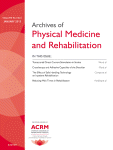
PHYSICAL THERAPY & REHAB
Fitness & vibration training improves muscle quality in older men over 1 year
This report has been verified
by one or more authors of the
original publication.
Arch Phys Med Rehabil. 2013 May;94(5):910-8. doi: 10.1016/j.apmr.2012.12.005. Epub 2012 Dec 16
97 older men were randomized to one of three groups to assess the impact of high- versus low-intensity training over a 1 year period and its residual effects. Patients were allocated to either a combined resistance and aerobic training (R+A) group, a whole-body vibration (WBV) training group, or a control group. Following evaluations over 2 years, results indicated that for the first year the combined resistance and aerobic training and whole-body vibration training programs equally improved patients' muscle volume, strength, quality, and power in the lower limbs. However, following the completion of the program most of these benefits on muscle volume were lost, whereas their residual impact on strength, quality and power differs somewhat, probably as a result of the specificities of each training principle.
Unlock the full ACE Report
You have access to {0} free articles per month.Click below to unlock and view this {1}
Unlock NowCritical appraisals of the latest, high-impact randomized controlled trials and systematic reviews in orthopaedics
Access to OrthoEvidence podcast content, including collaborations with the Journal of Bone and Joint Surgery, interviews with internationally recognized surgeons, and roundtable discussions on orthopaedic news and topics
Subscription to The Pulse, a twice-weekly evidence-based newsletter designed to help you make better clinical decisions
Exclusive access to original content articles, including in-house systematic reviews, and articles on health research methods and hot orthopaedic topics
Or upgrade today and gain access to all OrthoEvidence content for just $1.99 per week.
Already have an account? Log in


Subscribe to "The Pulse"
Evidence-Based Orthopaedics direct to your inbox.
{0} of {1} free articles
Become an OrthoEvidence Premium Member. Expand your perspective with high-quality evidence.
Upgrade Now













































































